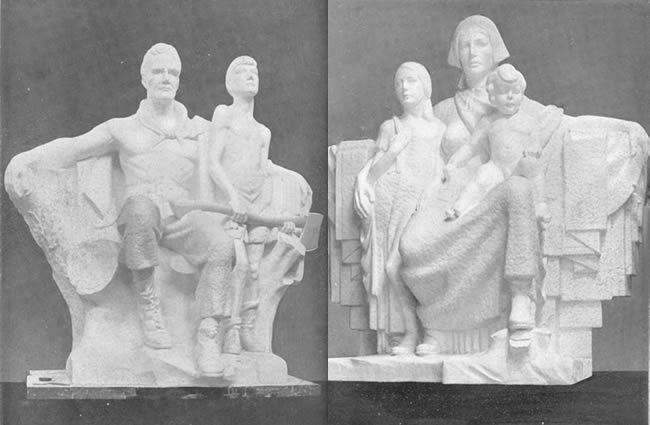Hear William Trethewey's description of his statues at the Centennial Exhibition.
Transcript
'Well I see on the door that it says "No admission except by special permission", but I think we've got special permission tonight Mr Trethewey?'
'Yes, yes.'
'I hope you don't mind?'
'Oh no, not at all.'
'And we've heard a lot about your, er, work and we've seen a lot about it in the newspapers. We'd just like you to tell our listeners what's going on in this room, um, for example, how many groups of statuary are you making?'
'Well at the present time we're engaged on three.'
'Uh huh.'
'There are two groups, as you walk up the main entrance steps, at either side of the main entrance, there are going to be two groups, one for the pioneer women and one for pioneer men of New Zealand.'
'Those are the two now finished?'
'Yes, they are finished.'
'Ah yes. They depict, as you might have seen listeners, on the one hand a man and a young boy isn't it?'
'That is so, yes.'
'And the other a women and two girls? A women and her two children?'
'That's right.'
'And they're to be placed at the base of the...'
'Of the main tower.'
'Yes, and that particularly, er, big group you are working on now, the one with clay and things on it?'
'Oh that is the, that depicts the coming of Kupe and Mana.'
'The original navigator to New Zealand?'
'Yes.'
'It is a particularly attractive figure – I shouldn't say attractive – it is really beautiful. You should see it for yourselves, listeners, you will do in due course. It depicts a group of three figures. What's the third figure?'
'The first figure is Kupe, and standing on his left is Mana, his wife, and the third figure is the Tohunga ...'
'Oh yes.'
'Who brought them out here.'
'He's standing on the prow of his canoe isn't he?'
'That is so.'
'At present Kupe is some 16 feet high, a particularly impressive group of statuary, and the spear reaches to a height of ?'
'22 feet.'
'22 feet.'
'22 feet, yes. It will be placed on a 10 foot base to make it 32 feet high when it's complete.'
'That small, um, bronze statuette is the one from which you work, isn't it?'
'Yes, that is so. The first thing we do is make what we call a preliminary sketch model.'
'Yes.'
'From the sketch model we enlarge the enlarged group, it's the first thing we do.'
'For the basis of the large group, for example, you'd have to use wooden frames?'
'Yes, we build up the frame with what we call an armature. And then with this armature of wood and iron, lead pipes et cetera, we spread a layer of scrim, and on top of this scrim we place clay.'
'Yes.'
'We build the clay all over until we obtain the figure we require, and then from that we have to make a mould in plaster of Paris. And from the mould, we cast the original.'
'Yes. What is the height of the two groups, Pioneer Men and Pioneer Women?'
'The two are 8 foot six.'
'8 foot six, that's what you call um?'
'Heroic.'
'Heroic, yes. And Mr Trethewey, the other groups that you're doing?'
'Well over the entrance doorway there is a very large panel, depicting the progress of New Zealand since 1840 to 1940.'
'That's the one they're finishing now, just over there?'
'Yes. The first portion shows the arrival of Captain Cook, and the coming of Christianity with Marsden, and then the pioneers.'
'That's all drawn out on paper?'
'Placed out on paper first, and then we're carving it in plaster of Paris.'
'Oh, you're carving it directly?'
'Yes, carving it direct.'
'Oh and that's what your doing over there?'
'That is so.'
'A method that has never been used in New Zealand before. You can imagine what a big task it is listeners, when I tell you that this frieze in bass-relief is 100 feet long by 8 feet high, and is to be carved into plaster of Paris?'
'Plaster of Paris, yes.'
'There's literally hundreds of figures in it.'
'Yes there are.'
'They've all got to be hand drawn first?'
'Oh yes, yes. Each figure is around about 7 foot six in height.'
'Where is the group, Kupe and Mana, to be placed?'
'The group Kupe and Mana is to be placed at the main entrance gates. As you go in the main entrance gates, the first thing that meets your eye, actually, is the very large lagoon, or reflecting pools you spoke of a while ago. At the head of this pool is going to be placed this group, looking along the water.'
'I see, what gave you the idea for that, Mr Trethewey?'
'Well, there's been quite a lot of talk about the Pakeha pioneers and it just occurred to me that a group to the Maori, the original Maori pioneers of New Zealand, would be quite appropriate.'
'I see, it is too. It's an amazing good piece of statuary – as far as I can see, it's the best group there. I may be biased. Well thank you very much. Our listeners are particularly interested, I know, in the statuary work that is being done, and we're very glad to have been able to get Mr Trethewey to open the door to us tonight.'

The seated pioneer man has a rugged face and windswept hair. Muscles are easily visible on his bare torso indicating how hard-working he is. Beside him stands his son holding an axe; he is a younger version of his heroic father. The statue of a pioneer woman depicts her sitting with two daughters: an infant on her knee and her older daughter standing. She is represented as a nurturing mother, but her unsmiling expression indicates that she is also serious.

Community contributions